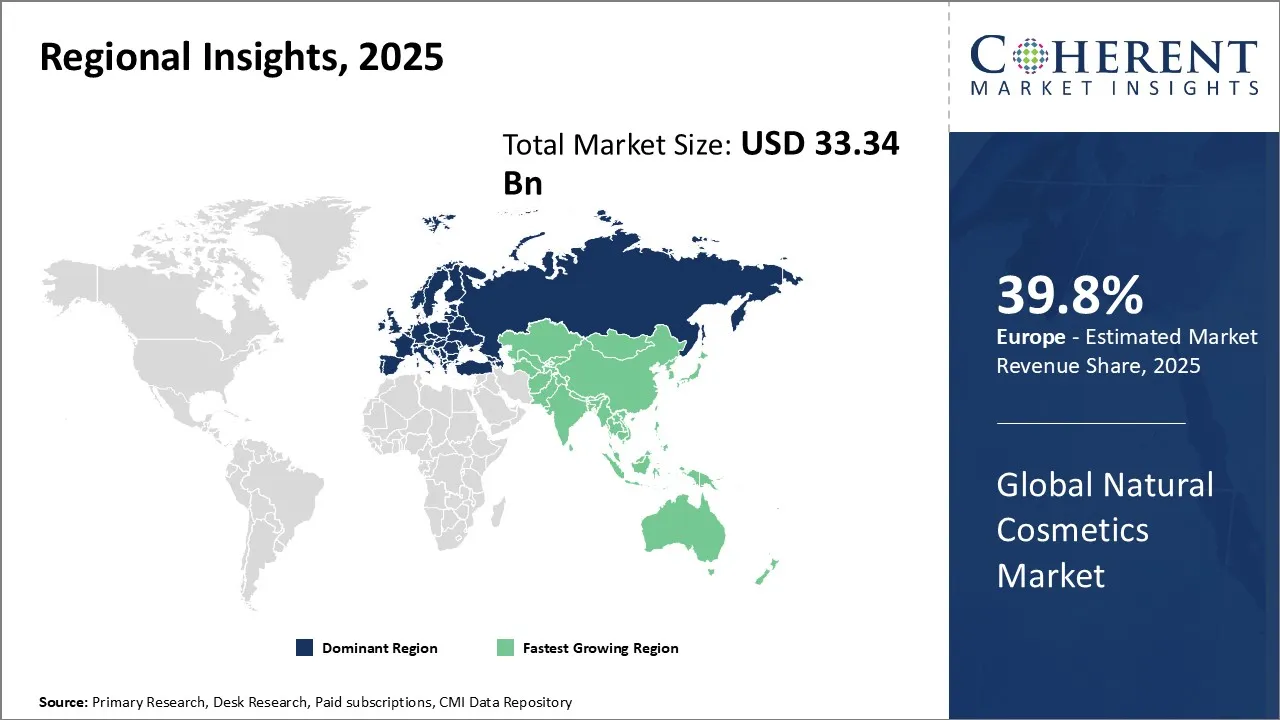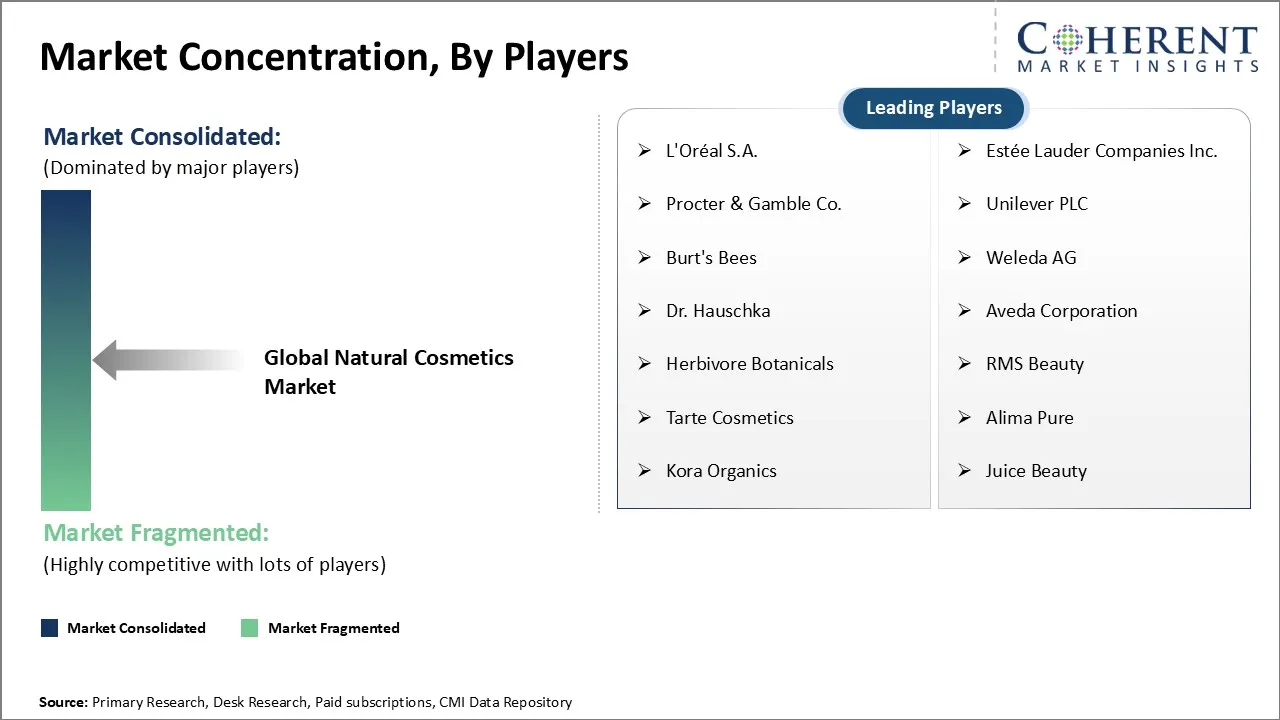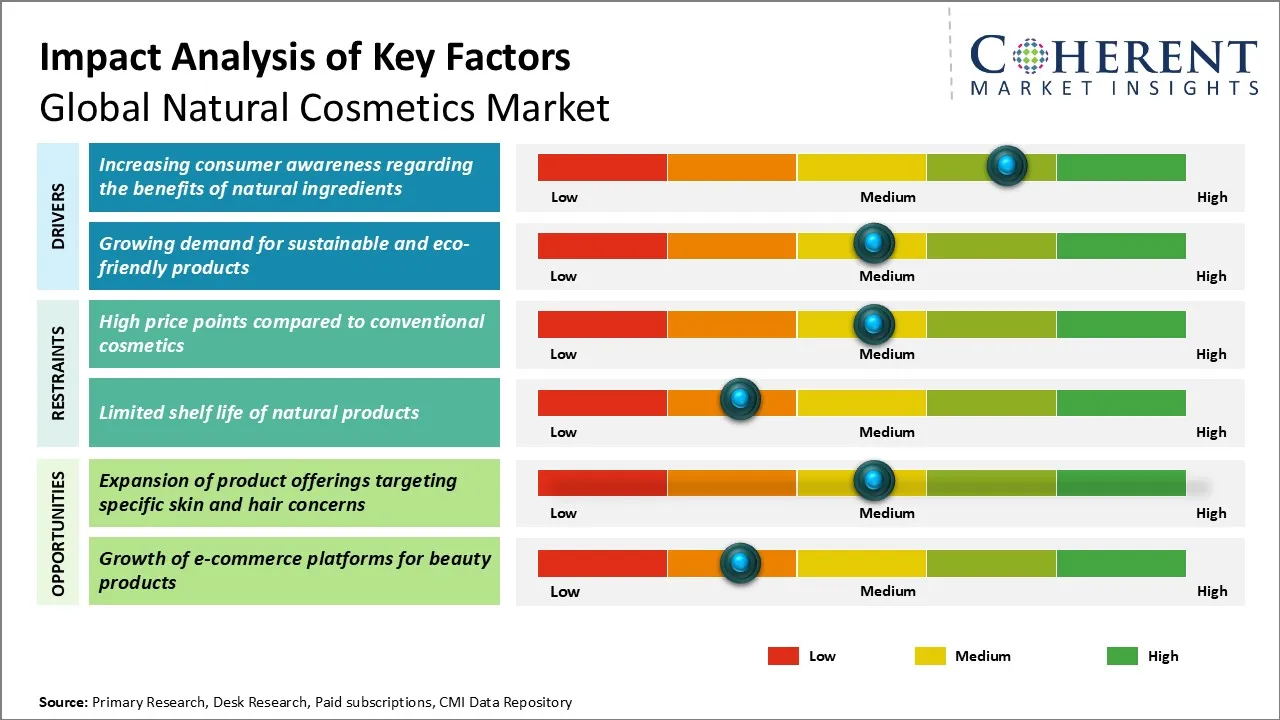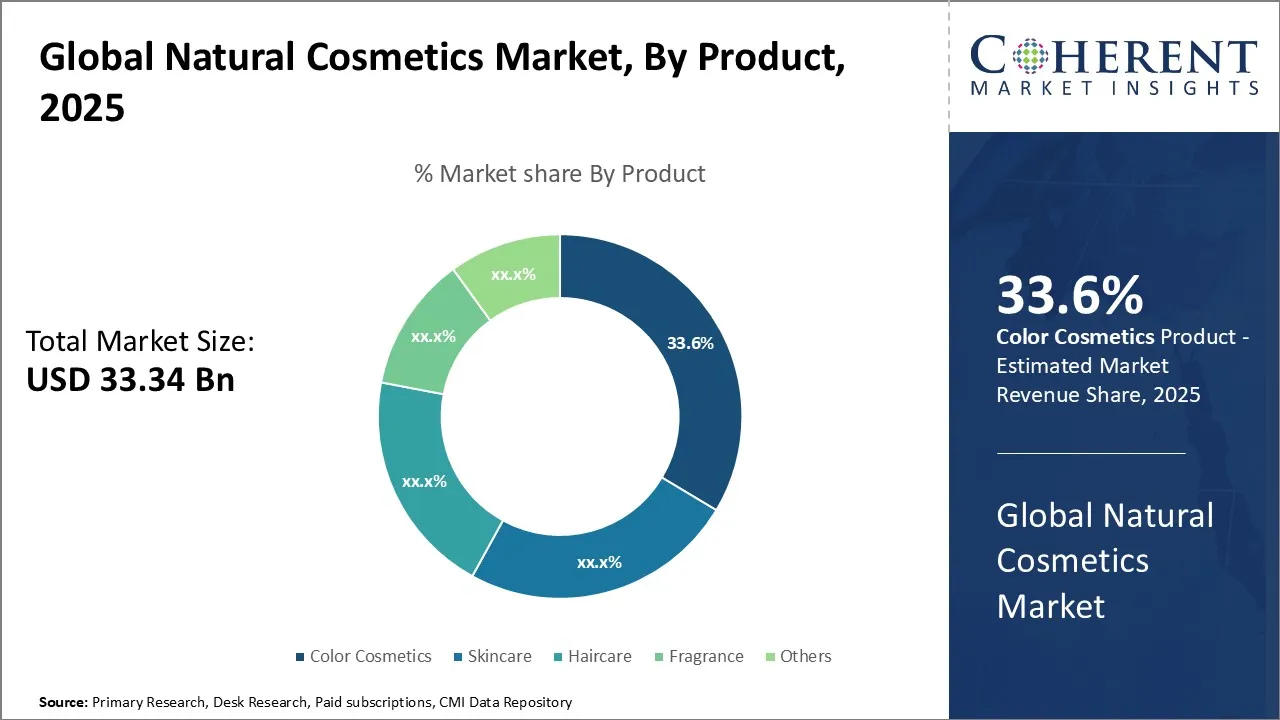Global Natural Cosmetics Market Size and Forecast – 2025-2032
The Global Natural Cosmetics Market is estimated to be valued at USD 33.34 Bn in 2025 and is expected to reach USD 47.54 Bn by 2032, exhibiting a compound annual growth rate (CAGR) of 5.2% from 2025 to 2032.
Key Takeaways of the Natural Cosmetics Market
- The color cosmetics segment is expected to lead the market in 2025, capturing 33. 6% of the market share.
- Botanical extracts are projected to hold a 32.6% share of the market in 2025, driven by broad recognition of their effectiveness, safety, and deep-rooted legacy in skincare and cosmetic practices across the globe.
- Supermarkets & hypermarkets are set to capture a 34.6% share of the natural cosmetics market in 2025.
- Europe will lead the global natural cosmetics market in 2025 with a 39.8% share, driven by clean beauty demand, strict organic regulations, and strong distribution in Germany, France, and the U.K. Asia Pacific, at 13.3%, is expected to grow the fastest due to rising incomes, natural skincare adoption, and expanding e-commerce access in 2025.
Market Overview
Current market trends indicate a strong shift towards cruelty-free, vegan, and eco-friendly cosmetics, reflecting broader societal moves toward sustainability and ethical consumption. Additionally, personalized beauty solutions and clean-label products are gaining traction, supported by innovations in biotechnology and cosmetics made of natural ingredients. Digital marketing and e-commerce are also playing key roles in expanding market reach, enabling brands to engage directly with informed consumers seeking transparency and authenticity in their cosmetic choices.
Current Events and Its Impact
|
Current Events |
Description and its impact |
|
Unilever Acquires Wild Cosmetics (USD 136.9 Mn) |
|
|
Unilever/L’Oréal M&A and Premium Natural Brand Focus |
|
Uncover macros and micros vetted on 75+ parameters: Get instant access to report
Natural Cosmetics Market Insights, By Product - Color Cosmetics Lead the Market Driven by Rising Innovation and Strong Consumer Appeal
The color cosmetics segment is projected to dominate the market in 2025, accounting for a 33.6% share. This segment’s expansion is primarily driven by a surge in consumer interest toward makeup products that not only enhance appearance but also boast clean, natural formulations devoid of harmful chemicals. Modern consumers, particularly Millennials and Gen Z, are increasingly conscious of the ingredients in their beauty products, favoring those that offer skin compatibility, ethical sourcing, and environmental sustainability.
The rise in social media influence further propels the color cosmetics segment’s growth. Beauty influencers and content creators emphasize natural makeup looks that highlight skin health, encouraging a shift from heavy, synthetic-based products to more natural counterparts. This creates an environment where brands innovate to launch natural lipsticks, foundations, eyeshadows, and mascaras that appeal to consumers seeking both safety and style.
Natural Cosmetics Market Insights, By Ingredient Type - Botanical Extracts Lead Ingredient Preferences Due to Proven Efficacy and Consumer Trust
Botanical extracts hold an estimated 32.6% share of the market in 2025. Their leadership stems from widespread acknowledgment of their efficacy, safety, and rich heritage in skincare and cosmetic traditions worldwide. Botanical extracts, derived from plants, flowers, and herbs, are favored for their natural antioxidant, anti-inflammatory, and moisturizing properties which resonate well with consumers looking to avoid synthetic chemicals and potential irritants.
Natural Cosmetics Market Insights, By Distribution Channel - Supermarkets & Hypermarkets Dominate Distribution Through Accessibility and Wide Consumer Reach
The supermarkets & hypermarkets segment is expected to claim 34.6% share in the natural cosmetics market in 2025. Their dominance is mainly attributed to the unmatched convenience and broad accessibility they offer to consumers. These retail formats serve as one-stop destinations for a wide array of products, including natural cosmetics, providing shoppers with the ease of purchasing beauty items alongside daily necessities. This convenience factor significantly drives consumer footfall and spontaneous purchases in these stores.
Regional Insights

To learn more about this report, Download Free Sample
Europe Natural Cosmetics Market Analysis and Trends
The Europe region is projected to lead the market with a 39.8% share in 2025, driven by a mature and well-established ecosystem that emphasizes sustainability, organic certification, and stringent regulatory standards. European governments actively promote the use of natural and eco-friendly products through supportive policies and regulations, such as the Cosmetics Regulation (EC) No 1223/2009, which ensures high safety standards and transparency.
Asia Pacific Natural Cosmetics Market Analysis and Trends
The Asia Pacific natural cosmetics market is expected to grow the fastest, reaching a 13.3% share in 2025. Growth is driven by rising awareness, disposable incomes, and wellness trends, especially in India, China, Japan, and South Korea. E-commerce expansion, supportive government policies, and demand for traditional-meets-modern formulations fuel momentum. Key players include Amorepacific, Shiseido, Kose, and Forest Essentials, with trade liberalization aiding both global and local brand penetration.
Natural Cosmetics Market Outlook for Key Countries
U.S. Natural Cosmetics Market Trends
The U.S. natural cosmetics market is characterized by a high consumer preference for organic and clean-label products, driven by increasing health consciousness and demand for transparency in cosmetic ingredients.
Major players such as Estée Lauder, Burt’s Bees, and Beautycounter focus on innovation in natural formulations and sustainable packaging. The U.S. market benefits from a robust retail landscape including specialty natural stores and online channels, enhancing accessibility. Regulatory bodies like the FDA regulate product safety but provide less stringent natural product labeling guidelines compared to Europe, which creates opportunities and challenges for market players.
Germany Natural Cosmetics Market Trends
Germany’s natural cosmetics market continues to lead in Europe with strong consumer demand for certified organic and vegan cosmetics. The country’s rigorous certification bodies like BDIH and NaTrue ensure product authenticity, building significant consumer trust.
German companies, such as Dr. Hauschka and Weleda, uphold the reputation for high-quality natural cosmetics grounded in biodynamic and sustainable farming practices. Germany’s role as a hub for ingredient innovation and cosmetics manufacturing supports both domestic consumption and exports, encouraged by government initiatives promoting green industries and eco-conscious consumption.
China Natural Cosmetics Market Trends
China natural cosmetics market is rapidly expanding, driven by increasing urbanization and government focus on clean beauty and natural health products. The Chinese government has expedited regulatory approvals for cosmetic ingredients and eased import policies to stimulate innovation and bring international natural brands into the market.
Local companies like Herborist and Inoherb blend traditional Chinese medicine principles with modern cosmetics technology, appealing to national pride and wellness trends. E-commerce platforms like Tmall and JD.com play a crucial role in distribution, allowing natural cosmetics to reach younger demographics and lower-tier cities.
India Natural Cosmetics Market Trends
India natural cosmetics market is witnessing robust growth, deeply influenced by ancient Ayurvedic and herbal traditions, which form the backbone of many natural cosmetic brands. Government programs supporting “Make in India” and promoting indigenous botanical cultivation provide a favorable policy environment.
Companies like Forest Essentials and Biotique have achieved wide recognition domestically and internationally by combining authenticity with contemporary cosmetic science. Increasing internet penetration and mobile commerce have expanded market reach significantly, while raising awareness about product safety and environmental impact continue to attract consumers towards natural offerings.
End User Feedback and Unmet Needs
Performance and Brand Alignment
A frequently cited area of satisfaction is the perceived safety and skin compatibility of natural formulations. For example, a leading European hotel chain integrating natural cosmetic amenities into their guest experience reported a measurable uplift in customer satisfaction scores. Guests responded positively to formulations free from synthetic preservatives, appreciating the alignment with sustainability and wellness values. Specifically, the chain cited that post-stay surveys showed a 27% increase in perceived brand authenticity and environmental responsibility, directly attributed to the use of certified organic personal care products.
Stability and Shelf Life
Conversely, a recurrent concern among professional salon operators and boutique retailers involves the stability and shelf life of natural cosmetic products. Many end-users report that certain formulations—especially those with minimal processing and no synthetic stabilizers—exhibit inconsistent texture or separation over time, requiring frequent manual mixing or refrigeration. One U.S.-based salon chain specializing in clean beauty treatments highlighted that nearly 40% of returned products were due to perceived spoilage or texture changes, which not only erodes consumer trust but increases operational burden.
Market Players, Key Development, and Competitive Intelligence

To learn more about this report, Download Free Sample
Key Developments
- On July 1, 2025, Sabon, the soap and cosmetics brand owned by Yves Rocher, announced the closure of its manufacturing plant, logistics center, and global headquarters in Israel. The shutdown will lead to approximately 270 job losses, marking a significant operational consolidation for the brand.
- In June 2025, Unilever signed an agreement to acquire men’s personal care brand Dr. Squatch from private equity firm Summit Partners. The acquisition marks a strategic move by Unilever to expand its presence in the premium, natural grooming products segment.
- In February 2024, SOULTREE introduced Soumya Rasa, an Ayurvedic product aimed at cleansing and rejuvenating the skin by removing impurities. The company also made strides toward environmental sustainability by adopting glass packaging, which significantly reduces plastic waste and resonates with eco-conscious consumers.
- In January 2023, L’Oreal unveiled two innovative technology prototypes: HAPTA, designed for individuals with limited arm and hand mobility, and Brow Magic, an electronic eyebrow makeup applicator that allows users to create personalized brow looks.
Top Strategies Followed by Global Natural Cosmetics Market Players
- Established players dominate the industry through substantial investments in research and development (R&D), which is pivotal in innovating high-performance natural cosmetic products that meet evolving consumer preferences for efficacy and sustainability.
- For example, L’Oréal, through its “Green Sciences” program, has invested heavily in biotechnology and sustainable sourcing to develop plant-based active ingredients that deliver clinically proven results.
- Mid-level players in the natural cosmetics market adopt a more cost-conscious yet quality-focused approach to navigate the competitive environment. Their key strategy revolves around offering cost-effective products that strike a balance between affordability and product efficacy, catering primarily to price-sensitive consumers who seek natural alternatives without premium pricing.
- For example, The Honest Company has carved out a strong market position with transparent ingredient sourcing and affordable clean beauty lines. Similarly, Burt’s Bees offers accessible natural skincare and personal care products that appeal to environmentally conscious but budget-minded shoppers.
- Small-scale players face unique challenges but carve out their niches by concentrating on specialized features or highly innovative products that distinguish them in a crowded marketplace. Many of these companies leverage cutting-edge technologies such as biotechnology for sourcing rare natural ingredients, eco-friendly packaging innovations, or AI-driven personalized skincare solutions to enhance product appeal.
- For example, Herbivore Botanicals uses sustainably sourced raw ingredients and eco-friendly glass packaging to appeal to design-conscious consumers. BYBI Beauty employs carbon-neutral production facilities and upcycled ingredients like fruit seed oils.
Market Report Scope
Natural Cosmetics Market Report Coverage
| Report Coverage | Details | ||
|---|---|---|---|
| Base Year: | 2024 | Market Size in 2025: | USD 33.34 Bn |
| Historical Data for: | 2020 To 2024 | Forecast Period: | 2025 To 2032 |
| Forecast Period 2025 to 2032 CAGR: | 5.2% | 2032 Value Projection: | USD 47.54 Bn |
| Geographies covered: |
|
||
| Segments covered: |
|
||
| Companies covered: |
L'Oréal S.A., Estée Lauder Companies Inc., Procter & Gamble Co., Unilever PLC, Burt's Bees, Weleda AG, Dr. Hauschka, Aveda Corporation, Herbivore Botanicals, RMS Beauty, Tarte Cosmetics, Alima Pure, Kora Organics, and Juice Beauty |
||
| Growth Drivers: |
|
||
| Restraints & Challenges: |
|
||
Uncover macros and micros vetted on 75+ parameters: Get instant access to report
Natural Cosmetics Market Dynamics

To learn more about this report, Download Free Sample
Natural Cosmetics Market Driver - Increasing Consumer Awareness Regarding the Benefits of Natural Ingredients
The growing consumer awareness regarding the advantages of natural ingredients is a significant driver fueling the demand within the global natural cosmetics market. More individuals today are prioritizing skin health and overall wellness, leading them to seek products that contain organic and naturally derived components rather than synthetic chemicals. This shift is largely influenced by increased access to information through digital platforms, social media, and wellness communities, where consumers actively share knowledge about ingredient safety, potential allergens, and long-term effects of synthetic additives.
For example, brands like The Body Shop and Weleda have experienced strong sales growth by emphasizing botanical extracts, plant oils, and fair-trade sourcing in their skincare and haircare lines
Natural Cosmetics Market Opportunity - Expansion of Product Offerings Targeting Specific Skin and Hair Concerns
The global natural cosmetics market presents a significant opportunity for growth through the expansion of product offerings tailored to address specific skin and hair concerns. As consumer awareness about the adverse effects of synthetic ingredients increases, there is a growing demand for natural cosmetic products that provide targeted solutions for conditions such as acne, eczema, dryness, frizz, hair thinning, hair loss and aging. Brands that innovate by formulating products with natural, clinically proven ingredients aimed at these particular issues can capture niche segments and foster brand loyalty.
For instance, The Body Shop has successfully captured the acne care segment with its Tea Tree Oil range, formulated using Community Fair Trade tea tree oil known for its antibacterial properties that help combat breakouts. Similarly, Aveda’s Invati Advanced line leverages natural ingredients like turmeric and ginseng to address hair thinning and promote scalp health, appealing to consumers looking for gentle yet effective solutions.
Analyst Opinion (Expert Opinion)
- The natural cosmetics market is experiencing remarkable growth, driven by a surge in consumer awareness regarding the health and environmental impacts of beauty products. Companies like Lush and Herbivore Botanicals are leading the way with formulations that prioritize organic ingredients and sustainable sourcing.
- Recent conferences, such as the Natural Products Expo West (2023) and the Sustainable Cosmetics Summit (2022), have highlighted the importance of transparency and ethical practices in product development. These events showcased successful case studies where brands have effectively communicated their commitment to sustainability, resulting in enhanced consumer trust and loyalty. As consumers increasingly seek products that align with their values, the natural cosmetics market is well-positioned for significant expansion, driven by innovations that cater to the growing demand for clean and eco-friendly beauty solutions.
Market Segmentation
- Product Insights (Revenue, USD Bn, 2020 - 2032)
- Color Cosmetics
- Skincare
- Haircare
- Fragrance
- Others
- Ingredient Type Insights (Revenue, USD Bn, 2020 - 2032)
- Botanical Extracts
- Essential Oils
- Natural Oils
- Others
- Distribution Channel Insights (Revenue, USD Bn, 2020 - 2032)
- Supermarkets & Hypermarkets
- Specialty Stores
- Convenience Stores
- Online
- Regional Insights (Revenue, USD Bn, 2020 - 2032)
- North America
- U.S.
- Canada
- Latin America
- Brazil
- Argentina
- Mexico
- Rest of Latin America
- Europe
- Germany
- U.K.
- Spain
- France
- Italy
- Russia
- Rest of Europe
- Asia Pacific
- China
- India
- Japan
- Australia
- South Korea
- ASEAN
- Rest of Asia Pacific
- Middle East
- GCC Countries
- Israel
- Rest of Middle East
- Africa
- South Africa
- North Africa
- Central Africa
- North America
- Key Players Insights
- L'Oréal S.A.
- Estée Lauder Companies Inc.
- Procter & Gamble Co.
- Unilever PLC
- Burt's Bees
- Weleda AG
- Hauschka
- Aveda Corporation
- Herbivore Botanicals
- RMS Beauty
- Tarte Cosmetics
- Alima Pure
- Kora Organics
- Juice Beauty
Sources
Primary Research Interviews
- Head of Product Development – Leading Organic Skincare Brand
- Sourcing Director – Major Natural Beauty Retail Chain
- Chief Innovation Officer – Well-Known Natural Cosmetics Manufacturer
- Regulatory Affairs Manager – Certified Organic Cosmetics Producer
Stakeholders
- Manufacturers
- End-use Sectors:
- Personal Care (Skincare, Haircare, Body Care)
- Color Cosmetics (Natural Makeup)
- Organic Baby Care Products
- Retailers & Distribution Channels:
- Specialty Natural Beauty Stores
- E-commerce Platforms for Natural Products
- Health & Wellness Chains
- Regulatory & Certification Bodies
- Packaging Suppliers (sustainable and biodegradable packaging)
- Ingredient Suppliers (botanicals, plant extracts, essential oils)
Databases
- UN Comtrade Database
- India Import Export (EXIM) Database
- Euromonitor International – Beauty & Personal Care Database
Magazines
- Natural Products Insider – Trends in organic and natural beauty
- Beauty Independent – Innovations and Indie Brands in Natural Cosmetics
- Organic & Wellness News – Global updates on natural personal care
- Cosmetics Design Europe – Regulations and innovation in natural cosmetics
- Natural Beauty Magazine – Consumer trends and product launches
Journals
- International Journal of Cosmetic Science – Research on natural formulations
- Journal of Ethnopharmacology – Plant-based cosmetic ingredient studies
- Phytotherapy Research – Efficacy of botanical extracts in cosmetics
- Journal of Dermatological Treatment – Clinical studies of natural skincare
- International Journal of Green Pharmacy – Sustainability in cosmetics
Newspapers
- The Guardian – Sustainability and green beauty consumer trends
- The New York Times – Growth of clean and natural beauty movement
- Financial Times – Market performance of natural cosmetics brands
- Asia Health Journal – Surge in demand for natural personal care in Asia-Pacific
- Business Standard – Indian market insights for organic beauty products
Associations
- Natural Products Association (NPA)
- COSMOS-standard AISBL (COSMOS Certification)
- Ecocert
- Soil Association (UK)
- Organic Trade Association
- Personal Care Products Council (PCPC)
Public Domain Sources
- FDA – Guidelines on cosmetics labelling and claims
- European Commission – Regulations on natural and organic cosmetics claims
- USDA – National Organic Program for cosmetics ingredients
- World Health Organization – Safety assessments of botanical ingredients
Proprietary Elements
- CMI Data Analytics Tool, Proprietary CMI Existing Repository of information for last 8 years.
Share
Share
About Author
Sakshi Suryawanshi is a Research Consultant with 6 years of extensive experience in market research and consulting. She is proficient in market estimation, competitive analysis, and patent analysis. Sakshi excels in identifying market trends and evaluating competitive landscapes to provide actionable insights that drive strategic decision-making. Her expertise helps businesses navigate complex market dynamics and achieve their objectives effectively.
Missing comfort of reading report in your local language? Find your preferred language :
Transform your Strategy with Exclusive Trending Reports :
Frequently Asked Questions
EXISTING CLIENTELE
Joining thousands of companies around the world committed to making the Excellent Business Solutions.
View All Our Clients


